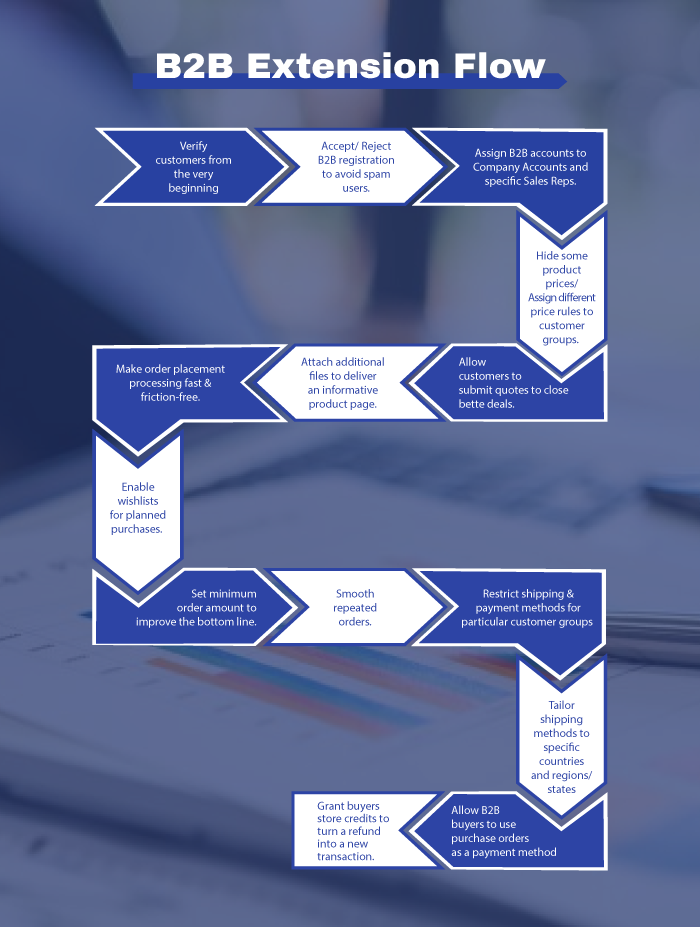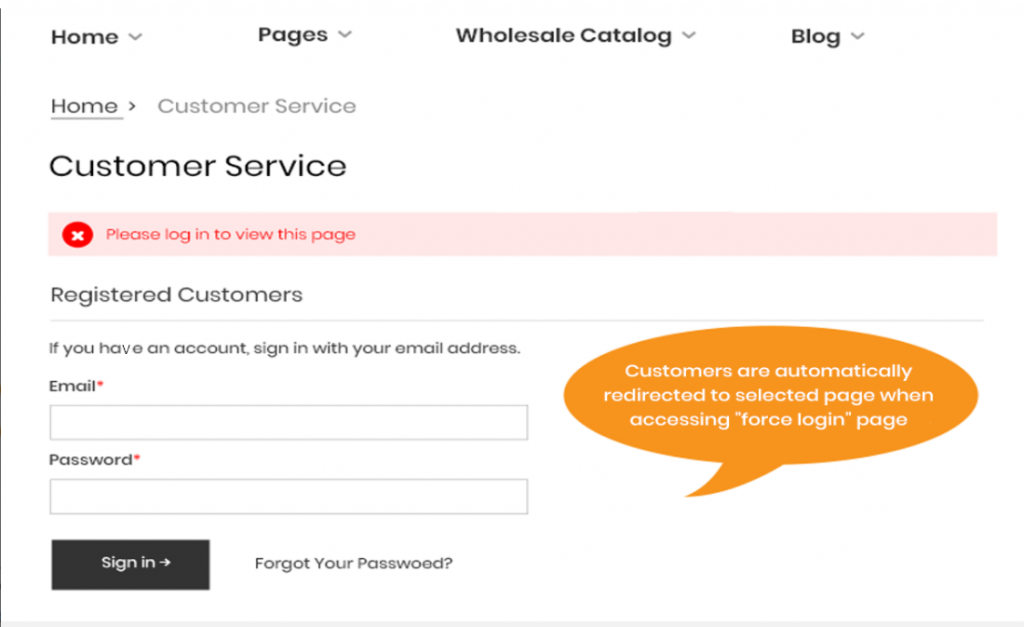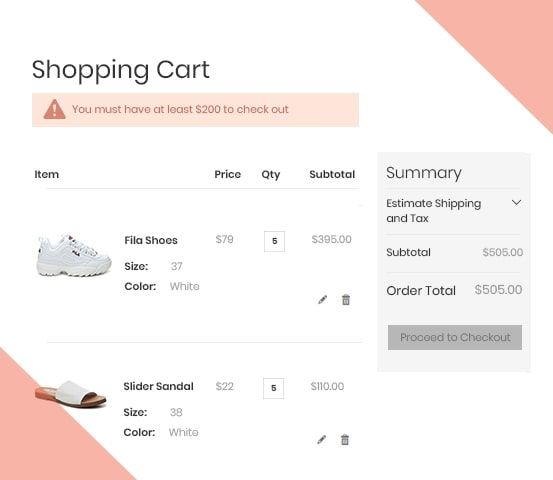The evolution of science and technology has urged tons of B2B companies to shift to the eCommerce business, which entails the construction and growth of a frictionless website. Unfortunately, B2B eCommerce website development poses various challenges to even the most competent developers.
For innovators and newly adopters, this article will help you lay the first tiles to build a durable website serving the harsh demands of corporate customers. Let’s check which steps you will have to take in the process of developing a B2B eCommerce website!
I – Before Implementing a B2B eCommerce Website
Table of Contents
1.1. Do Market Research and Define Your Niche
Before starting B2B eCommerce website development, store owners must have decided what they will provide to the market based on their resources and demands. However, without understanding what wholesalers want, all your effort into building a website would aim for nothing.
To not drive yourself to that edge, it’s wise to take a look at some typical examples of successful B2B eCommerce pioneers such as Alibaba, Amazon business, Spectrum Audio, Human solution, and many more. Here will suggest which you should explore those giants’ sites to address the question “How to create a b2b e-commerce website”.
Take a Look at Trending Products
The majority of us are captured by on-trend products, so do corporate customers because their end-users are We – consumers. A safe way is to align your business with products currently receiving high demands. For example, a plethora of online stores has manufactured and provided face masks in the CoVid-19 pandemic.

Otherwise, you can attack an untapped market. There are always demands that haven’t been met by any or very few suppliers. If you can discover this niche and quickly satisfy their hunger, chances are your B2B eCommerce website will thrive in the near future.
There are many different tools available that can assist you in defining which products are drawing consumers’ attention at present.
For example, you can use Google Trends to see the ups and downs of product lines, which reflects the popularity of a market and helps you assess customers’ behaviors. Also, follow influencers on social media channels like Facebook and Instagram to identify items that are being promoted strongly on their pages.
Consider Your Resources and Budgets
Fortunately, the data collected above will suggest a forest of products in various industries, so you’re likely to find a niche attached to your business plan and budget. Even when you’re keen on innumerable product types, make sure to align with your at-hand resources to choose suitable items.

1.2. Well Prepare Crucial Data for B2B Website Building
If you fail to draw up needed data before starting B2B eCommerce development, you’re prone to face challenges due to lacking experience and resources.
Resource Arrangement
It’s essential to plan and own enough resources to serve the growth of your B2B eCommerce website development. You can make use of internal resources or outsourcing.
Budget
Although store owners nurture enormous ambition, you still have to operate a website attached to your budget constraints. Careful preparation in advance will help you avoid unnecessarily added fees in the process of B2B web development.
Only when you allocate your budget smartly and invest in robust online tools can your B2b eCommerce business generate more sales, ensure ROIs and launch the website to a higher level.
CHECK Magento B2B pricing to estimate how much building a Magento 2 B2B website will cost you.
Competitor Scanning
Sun Tzu once said “If you know the enemy and know yourself, you need not fear the result of a hundred battles.” and this saying remains true in the B2b eCommerce world.
Selling in a competitive environment like this, it’s a must to minimize the gap between your business and your competitors’. You should dive into their B2B websites and analyze their performance, brand voice, customer engagement, marketing and sales events, and many more.

We highly suggest using trusted tools such as Google Analytics, Adwords, SEMrush, SEOquake, Ahrefs, Keywordtool.io, and so on. Not only following their strengths, but you can also learn from the competitor shortage and imperfection.
1.3. Know B2B Buyer Personas and Target Customers
The question “Who are my target customers?” should even come first before addressing the “How to create a b2b e-commerce website”.
It would be a huge advantage if you start your B2B eCommerce website in a field that you know your customers well. Yet, you should still take some more actions to understand them deeply.
Let’s clarify your target audience and their personas to match their behaviors with every touchpoint of business development. This enables you to tailor the website functionality to corporate customers’ demands related to the user interface, visuality, professionalism, b2b eCommerce website design, content, and more.

Source: react-digital.com
To depict an exact B2B buyer persona, some questions should be raised: What’s the company vision?; What are their goals?; Is it a large or small company?; Do they also refer to your competitors?; What’s their business model?; etc.
Once collecting these details, you will be able to create a B2B website delivering a personalized experience for B2B customers and thereby empower long-term B2B customer relationships.
1.4. Pick A Suitable Platform for Your B2B eCommerce Development
Many platforms with different capabilities and a wide range of costs appear on the market to suit even the tightest budgets. Below are famous eCommerce platforms being used by countless store owners all over the world.
Magento
Coming first on the list, Magento has long been known as the most popular platform for eCommerce sites.

From recognized brands like Samsung, Ford, FoxConnect, Lenovo, Olympus, Men’s Health, Vizio, Nestle, Nike, to millions of small-to-medium-sized commercial companies around the world – all of them utilize Magento for their business sites.
For its commercial capabilities and security, Magento is preferred by a majority of B2B business owners. Although Magento Open Source edition lacks some features serving wholesale needs, it still offers high customization ability to integrate crucial Magento 2 B2B extensions.
Thanks to its popularity, Magento attracts an ocean of service and extension providers on the market, which brings you diverse solution choices to support your B2B website performance.
- Robust admin management;
- Extensive Magento 2 B2B features;
- No limit for customization;
- A considerable number of Magento 2 extensions and themes for better website development;
- Mobile-friendliness;
- SEO-friendliness.
In short, this platform is a perfect option for those running a medium-to-large B2B business or wanting to function as a sustainable website.
WordPress & WooCommerce
Our second candidate is a self-hosted and open-source platform where WordPress gives you control over the website design and WooCommerce over the payment. It’s preferred by Internet users thanks to its versatility. In fact, you can utilize WordPress for almost all purposes from writing personal blogs to selling products.

However, it lacks some needed features when it comes to B2B eCommerce website development. Since corporate customers expect a smooth purchase process that is both professional and personalized, WordPress fails to meet those requirements in some ways.
Shopify
Perhaps Shopify is the easiest platform to create and customize. As it’s quite cheap and convenient to build an eCommerce store on Shopify, experts don’t recommend this for businesses that require extreme professionalism and streamlined experience like B2B.

1.5. Essentials for B2B eCommerce Website Development
Bear in mind that developing a B2B website is much more tricky than simply creating a basic website or blog.
Besides getting a domain name and server hosting, you must explore more online tools and software that ease the purchase process, negotiation, data management, and more to satisfy customers and simplify your business operation.
We break down here some required elements to form a standard B2B eCommerce website development procedure:
- Domain and server hosting selection;
- Website development service hiring;
- Theme selection;
- B2B features integration;
- Marketing practices;
- Maintenance and support.
>>> Check this for more information: Magento Vs WooCommerce: Which One Was Developed For You?

II – In Progress of B2B Website Implementation
2.1. Buy a Domain Name and Server Hosting
A domain name plays as an identification card to confirm your website’s existence. You can easily purchase a domain at different price points from a variety of providers on the market.

Source: Google Small Business
The same can be applied to the hosting service. Simply put, you need a stable place to store necessary contents of the website such as systems, images, videos,… But you cannot use your personal computer, because different access to the Internet will be subject to a change of IP address through the IPS. That’s why we need hosting to keep the website’s content safe.
Moreover, it ensures users can access your B2B website wherever they want.
2.2. Form A Team of Web Developers
The web developer is a must-have component in launching a B2B eCommerce store. They are like artists who make sure your website appears as appealing and functional as possible.
Based on your financial situation and expected results, you can decide whether to hire a web development agency, a freelance developer or build your own development team.

2.3. Use a B2B Theme Matching Your Business Goal
You know, the layout is the first thing that strikes customers’ eyes strongly before they can pay attention to your content. A dull appearance has never drawn user attention, which surely can’t generate much sales volume.
Therefore, remember to wear a seducing B2B eCommerce website template for your website to convey the messages exactly and speak your brand voice loudly.

Both free and paid themes are at your hand to select. Nevertheless, for you’re doing transactions with corporate customers who are hard to compromise, we highly recommend you choose a paid theme for further customization and presentation.
TAKE A LOOK AT the collection of Magento 2 themes to select the most beautiful face for your B2B website.
2.4. Include Essential Elements for a Website
A website must cover these fundamental capabilities to ensure the highest customer satisfaction and increase conversion rates.
Arrange Your B2B eCommerce Website According to Purchasing Flow
To have an organized website, the first thing you should do is decide which pages and categories to be included. Every commercial store has to present a homepage linked to different product pages.
However, the question here is how those product pages should be arranged so customers can conveniently find what they need.
As we mentioned above, before starting the B2B eCommerce website development, you must grab B2B buyer personas and purchase flow in your hand.

Once you’ve managed to do that, you can think the way your customers think and figure out what steps they will go through. From there, you can shape the site structure to facilitate the buying journey.
For example, assume you’re running a footwear and accessories store. You may categorize products into different genders and ages, including men, women, kids.
Among them, the subcategories display product types like boots, sandals, bags, accessories. Thanks to that, visitors can quickly narrow down their search funnel based on their specific needs.
Create a Convenient Search Bar
Don’t ignore your site search bar because it plays as a navigator leading your customers to the right place. Especially, your target audience is companies who tend to place bulk orders, so they require a quick and precise search tool.
Let’s optimize its accuracy to direct users to related content and encourage them to take desired actions.
Use Secure Firewalls
You can beautify your brand image and attach to customer’s interest by implementing proper security protocols and PCI compliance.

Fasten Page Loading Speed
Speed matters so much, especially in B2B websites where large transactions often take place. The image below will prove our conclusion.

Source: LoadStorm, Econsultancy
B2B customers have a lot of tasks to do and no time for unexpected delays. Thus, strive to boost the speed of your website as fast as possible to deliver hassle-free shopping experience and pleasant navigation.
Include Review Section
The online environment acts as a deterrent to direct communication, so it’s hard for sales reps to persuade corporate customers to do business with your company.

To check the credit of your business, buyers have to read reviews of real customers about product quality. When time passes, this has become a habit of both B2C and B2B online shoppers.
Review sections on your own website and on third-party sites must be added to reinforce your customer trust. They deserve the right to hear what people are saying about your products. And if reviews are positive, chances are more and more customers will be drawn to you.
Improve Website Security
Selling online requires a high level of data security. At a minimum, plan to secure your site using SSL certificates, provide user authentications, and set up permission rules.
If you handle online payment transactions, work with your card processing services and be sure you are PCI (Payment Card Industry) compliant.
Use SSL to Protect Your Customers
SSL stands for Secure Sockets Layer. This is a global technology security standard that creates a link between the web server and the browser. This link ensures all data exchanged between the web server and the browser is always confidential and secure.
For its safety, SSL has been used by millions of websites in securing online transactions with their customers. To be more specific, a URL containing “https://” instead of “http://” means it’s secured by SSL.
Corporate customers extremely appreciate privacy, so they may feel in danger when visiting your website and seeing that they aren’t protected. It will negatively affect customer engagement in the long run. Therefore, remember to include the SSL certificate on your website.
2.5. Infuse Your Online Store with B2B Features
Of course, in no way can you offer a B2C website to B2B customers. Meanwhile, we notice that many wholesale sites are missing several B2B-driven features that could help yield more sales and enhance UX.
If you want to build a blue-ribbon website that can show off your professionalism and brand image, then make sure your store is filled with full B2B capabilities.
Access Restriction
In B2B businesses, some information related to prices and manufacturing recipes can’t be public since it can be harmful to the competitive edge.
Moreover, in case your store supplies products to different customer groups, you may tailor various preferential policies to specific audiences, which can cause jealousy and confusion among your customers.
As a result, restricting access to exclusive content is vital in B2B companies to prevent competitors from stealing your business tips and blow out customer dissatisfaction.

For example, imagine you created a category for corporate customers, surely you don’t want a B2C customer to know about this place. This time, your site will need the accessing-block feature.
Customer Segmentation
For websites serving multiple customer groups, it’s indispensable to cover a feature supporting in segmenting customers precisely. A concise registration form will help you do that.

After blocking guest access to a specific page, don’t leave them alone; instead, let’s redirect them to a registration page. This place will be the first welcome gate that motivates guests to sign-up and join your customer network.
Not only does a B2B registration form enable you to collect customer data and categorize them, but it simplifies your sales management as well.
Multi-users with Shared Accounts
Unlike their counterparts, corporate customers share their buying journey with many individuals in their company, which raises the demand for a company account. With this feature, company members with specific roles and permissions can easily login and access the assigned resources for effective management.

Flexible Price Strategies
Also, it would be a big mistake if your site lacked the ability to sharpen pricing strategies. Some features, such as hiding prices and personalized pricing, can work great in protecting your competitiveness and strengthening the power of your pricing policy.

For a friction-less B2B website development process, leverage these tools to deliver the right price messages to the right audience.
Quote Management
Merchants are accustomed to going through the negotiation stage to finally close the deals. Often, certain products and categories won’t display prices, which forces B2B customers to submit a quote. Then, the admin users will approve/ requote/ or reject that quote. The information is flushed back to the customers’ dashboard, and this continues until a deal is sealed.
The key point here is your site needs a tool to streamline the quotation process. If your platform lacks this functionality, let’s seek an extension on the market.
Minimum Order Amount (MOA)
Setting a minimum order amount is necessary to improve your bottom line. Running a B2B eCommerce website means that you manage a large inventory that is sold on a daily basis. Store owners will have to check regularly and determine a reasonable minimum order quantity based on your target customers and ROI.
TAKE A LOOK: Magento 2 Reorder Product List module for customers to bulk order faster at ease!

Quick Bulk Order and Reorder Functionality
A quick order form would be the best choice to fasten the purchase. Integrate your store with an option to place orders under a form without navigating to every single product page.
Also, you should pay enough attention to repeated orders because the return rate of B2B transactions is quite high. It would be great if the customer dashboard can save ordered product lists for later repurchase.
SPEED UP the purchasing process with Magento 2 Bulk Order Processing Kit to reduce cart abandonment rate!
Saving Lists for Interval Purchases
While B2C customers go shopping depending on their emotions, B2B counterparts usually plan what to buy in advance to suit their sales campaigns. This characteristic generates a necessity for space so customers can save their favorite items for later orders or repeat purchasing plans.
Diverse and Safe Payment Portals
Some payment methods such as a credit card and Paypal makes sense in a B2C business, but in terms of B2B eCommerce websites, it’s another story. You need to enable your clients to easily pay any way they want to.
Moreover, since you provide to different customer groups located in different countries and regions, you may want to restrict shipping and payment methods to specific customers and groups. A comprehensive B2B website should include a feature allowing you to do that to ensure personalization.
2.6. Test your B2B Website Before You Go Live
Before officially releasing any products, it’s important to test your site’s performance. Testing facilitates store owners to view your website from the customer’s perspective and then make measurable changes.
Certified testers need to check your website performance at the best and worst cases. Here present some elements to be kept on track:
- Ensure no broken links;
- Remove all website bugs;
- Make web usability a top priority;
- Define which factors are leading to cart abandonment;
- See if your website is user-friendly;
- Rescan all content to make sure no spelling mistakes;
- Check if visitors can navigate freely;
- Be compatible with all devices.
2.7. Go Live
Now, after checking carefully, your B2B eCommerce website development will move to the launching phase. Please note that you can still recheck and make adjustments while running your online store, so let’s go live to explore deeper into customers’ insights and attract potential audiences.

Some tips below will help you avoid disasters:
CONTACT US now!
- Always prepare an alternative strategy in case you confront some unexpected bugs;
- For a refurbished B2B store, you should pick a time slot when the least number of customers visit your website;
- Monitor and analyze indicators to handle timely if any problem arises;
- Not compulsory, but launching on weekdays is recommended to avoid the overload of weekend traffic.
III – After Launching B2B eCommerce Website
3.1. Leverage Digital Marketing to Inform About Your Live Site
Blog Creation
In a competitive business model like B2B, blogging forms a loyal fan base who has an interest in store owners’ products and services.

One of the biggest challenges is not knowing what to write about. To remain effective in building your blog content, you must do keyword research to find the right focus terms for your site. For instance, tools like Keyword Planner, Keyword Tool, or SEMrush will bring good suggestions on high-traffic keywords.
Your audience entrusts Google to seek a solution to their problems. Maybe they’re looking for the best B2B product supplier for their needs. Google will save these queries. Your job is just to use tools to see what problems corporate customers are facing.
The next action is writing a great article to solve the problem.
Blog creation is a more friendly way to communicate with customers. You may notice the following benefits:
- Remove barriers gradually with doubtful customers;
- Convert blog readers into buyers;
- Branding;
- Build brand presence;
- Give existing customers another reason to engage.
You’ll also need to use SEO articles to drive traffic, but try some of the other ideas for trust reinforcement:
- Notification of major changes such as redesigning the frontend, adding features, launching new products, and so on;
- Product reviews;
- Product manual;
- Whitepapers on how your company has helped other businesses save costs and streamline their logistics operations;
- Industry news (and news about your B2B eCommerce company);
- Expert interview;
- Rotation between posts and a little bit of technical SEO creates perfect blogs. Not only can you drive traffic for your B2B website, but conversion rates also increase from there;
- Downloadable product catalog.
Email Marketing
Social media is important, but email is still one of the most seducing marketing tools. Furthermore, it’s the most secure method. Also, B2B email campaigns are more lucrative than B2C ones since corporate customers use professional email daily, meaning you stand a good chance of getting their attention.

A way to make sure your emails stand out in their inboxes and maximize profits with email marketing is email personalization. Send your readers relevant offers. If you tailor the email content to receivers, they are more likely to join your conversation or contact you to work.
SEE which are the best email marketing services IMMEDIATELY to optimize your strategies.
#Case 1:
If your customer belongs to the weekly email recipient list, you can set up an automated email to ask “Did we do something wrong?” if they haven’t opened your email for one week. Surprisingly, this automation setup is effortless, and can significantly maintain your weekly email open rates. It can even save you a huge amount of money for reaching a new customer.
#Case 2:
Assume you’re running a promotion for a certain item. You can segment the people who frequently order and those who never place an order. Send two different emails.
- For regular customers, you can send them a discount combo.
- For new customers, you can tell them why right now is the best time to try their products at a discounted price.
This strategy will increase your sales in both segments by simply taking the time to personalize your email.
SEO
Search engine optimization (SEO) encompasses tactics that level up your website’s authority according to the factors valued by search engine algorithms. In other words, SEO presents how websites increase their chances of showing up on the top results of search engines like Google and Bing.

Basically, SEO includes a few practices, such as:
- Keyword research: This is an initial step because SEO functions on targeting the specific keywords you want to rank for. You can use many SEO tools to discover what terms the consumers are commonly searching for.
- On-site optimization: At this stage, you have to ensure the B2B website meets all technical standards, like fast loading speed. It also means ensuring that every page is optimized for the chosen keywords.
- Content marketing: Google extremely appreciates unique and quality content. Thus, strive to create great content that keeps your website fresh, informative, and gives you the chance to target more keywords.
- Link building: The search engine algorithms regard backlinks as a measure of how valuable other people rate your website. Needless to say, they’re a vital ranking factor. Link building involves encouraging other websites to link back to yours.
Find more useful function of Magento 2 SEO extension now to rank higher on search engines and increase brand awareness.
3.2. Evaluate your B2B eCommerce Website Performance
Running a B2B eCommerce business requires interval evaluation of the website performance to figure out shortages for timely adjustments. We suggest using tracking codes, accurate monthly reports, and behavior analysis for the best analytics. Pay attention to some metrics:
- Monthly traffic and sources including search engines, social channels, referral, paid ads, and more;
- Conversion rate (completed orders/ traffic volume);
- Product sales volume;
- Average order value;
- Return on advertising spend (ROAS);
- Session average duration & average time on page;
- Bounce rate;
- Shopping cart abandonment rate.
You can base on these to depict a clear vision of your B2B eCommerce performance and which areas need improvement.
3.3. Maintain and Upgrade B2B Website Performance
When you see that the features on your B2B site are limited and can’t meet the current requirements as well as future scalability, it’s time to use maintenance and upgrade services. Regular website enhancement has some benefits, as follows:
- Streamlined business operation and management;
- Perfect user experience;
- No security flaws.
IV – Rely On Magento 2 B2B Website Development Service
In general, the B2B eCommerce website development process above can be applied with the Magento platform. For Magento store owners, it’s easy to realize that the procedure of B2B eCommerce website development takes much time, effort, and a good deal of expertise in developing.
If you’re an early adopter and bewildered by too many options on the market, the optimal solution is to find a Magento 2 B2B website development agency.

There are 4 main reasons why you should hire a comprehensive B2B website development service.
First, certified developers will cover the entire site-building process from receiving requirements of clients to maintaining.
Second, you won’t need to worry about B2B functionality shortcomings and unnecessary conflicts.
Third, a trusted agency has the ability to make customization requests with satisfaction, helping to increase your professionalism and brand awareness.
Finally, you will be able to save a huge amount of time in B2B eCommerce website development.
A common site-building process by agencies goes through the steps we outlined above. Our development cycle begins with choosing your hosting and theme providers, installing full Magento 2 B2B features, further customization, ERP integration, testing, and maintaining site performance.
Conclusion
In brief, we’ve shared basic steps of common B2B eCommerce website development that can be totally applied to Magento stores. Don’t forget to include crucial Magento 2 B2B features to optimize your site functionality and smooth wholesale buying journey!
CONTACT US now!

